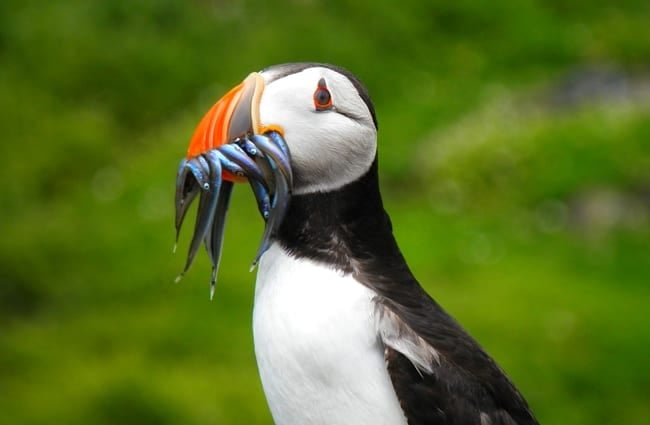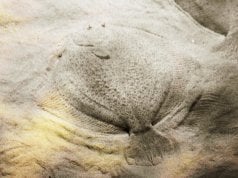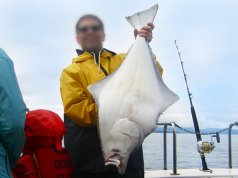The Puffin: A Charismatic Seabird of Northern Seas
Few birds capture the imagination quite like the Puffin. With their distinctive, brightly colored beaks, comical waddle, and endearing gaze, these “sea parrots” are more than just pretty faces. They are master mariners, dedicated parents, and vital components of the northern marine ecosystem. From their dramatic cliffside colonies to their incredible underwater acrobatics, the Puffin offers a fascinating glimpse into the wonders of avian adaptation and the delicate balance of our oceans.
This article delves into the captivating world of the Puffin, exploring its life cycle, ecological role, and interactions with both its environment and humanity. Whether you are a student researching their unique behaviors, an animal lover hoping to spot one in the wild, or an aspiring zoologist seeking deeper insights, prepare to be charmed by the Atlantic Puffin and its relatives.

Meet the Puffin: An Introduction to the “Sea Parrot”
Puffins are a genus of seabirds in the auk family (Alcidae), renowned for their striking appearance during the breeding season. There are three main species:
- Atlantic Puffin (Fratercula arctica): The most widely recognized species, found across the North Atlantic.
- Horned Puffin (Fratercula corniculata): Native to the North Pacific.
- Tufted Puffin (Fratercula cirrhata): Also found in the North Pacific, distinguished by its long, yellow head plumes.
While each species has its unique characteristics, they share common traits: a stocky body, short wings adapted for both flight and underwater propulsion, and that unmistakable large, triangular, brightly colored bill which fades to a duller grey outside the breeding season. Their plumage is typically black or dark brown on the back and white on the belly, providing effective camouflage against predators from above and below.
Where to Find These Marvelous Mariners: Puffin Habitats and Observation
Puffins are birds of the open ocean, spending most of their lives at sea. However, they are inextricably linked to land for one crucial purpose: breeding. Their breeding grounds are typically remote, rocky islands and coastal cliffs across the North Atlantic and North Pacific.
- Atlantic Puffin Habitat: Look for them on islands off the coasts of Iceland, Norway, the Faroe Islands, Greenland, Newfoundland, Labrador, and parts of the United Kingdom (e.g., Scotland, Wales).
- Pacific Puffin Habitats: The Horned and Tufted Puffins inhabit coasts and islands from Alaska down to California, and across to Siberia and Japan.
Finding Puffins in the Wild:
The best time to observe Puffins is during their breeding season, which generally runs from late spring through late summer (typically May to August). During this period, they gather in large, bustling colonies on cliff tops and grassy slopes. Key tips for observation:
- Location: Research specific Puffin colonies known for accessibility and viewing platforms. Many boat tours operate to these sites.
- Timing: Early morning or late afternoon often provides the best light and activity.
- Equipment: Binoculars or a spotting scope will greatly enhance your viewing experience.
- Respectful Observation: Maintain a significant distance to avoid disturbing the birds, especially near nesting burrows. Use designated viewing areas.
Life on the Ocean and Land: Puffin Behavior
Puffins are incredibly agile in two very different environments: the air and the water. Their flight is characterized by rapid wing beats, a necessary adaptation for their dense bodies. Underwater, they are true acrobats, using their wings to “fly” through the water with remarkable speed and precision, steering with their webbed feet.
- Foraging: Puffins are pursuit divers, capable of diving to depths of 60 meters (200 feet) or more, though most dives are shallower. They can stay submerged for up to a minute, using their powerful wings to propel themselves through the water in pursuit of fish.
- Social Life: While solitary at sea, Puffins are highly social during the breeding season, forming dense colonies that can number in the tens of thousands. This colonial nesting provides some protection against predators.
- Vocalizations: Puffins are generally quiet at sea, but their colonies are filled with a variety of guttural growls and grunts, particularly during courtship and territorial disputes.
Encountering a Puffin in the Wild: What to Do
If you are fortunate enough to encounter a Puffin in its natural habitat, remember that these are wild animals. Your presence should not disrupt their natural behaviors.
- Observe from a Distance: Always keep a respectful distance. Use binoculars for close-up views.
- Stay on Designated Paths: Many colonies have established paths to protect both the birds and their burrows from accidental damage.
- Never Feed Wild Animals: Feeding can alter their natural foraging behaviors and make them dependent on humans, which is detrimental to their survival.
- Do Not Disturb Nests or Chicks: Approaching burrows or young birds can cause stress to the parents and make the chicks vulnerable.
- Report Injured Birds: If you find an injured Puffin, contact local wildlife authorities or conservation groups. Do not attempt to handle it yourself.
The Puffin’s Sustenance: Diet and Foraging Strategies
Puffins are primarily piscivores, meaning their diet consists almost exclusively of fish. Their foraging prowess is legendary, particularly their ability to hold multiple small fish crosswise in their bill. This remarkable feat is possible due to specialized serrations on their bill and a unique tongue structure that allows them to pin fish against the roof of their mouth while continuing to hunt for more.

Key Dietary Components:
- Small schooling fish: Sand eels (also known as sand lances), herring, sprats, and capelin are staple foods. The availability of these fish is crucial for breeding success.
- Invertebrates: Occasionally, particularly when fish are scarce, Puffins may supplement their diet with marine invertebrates, though this is less common.
The nutritional quality and abundance of these prey fish directly impact the growth and survival of Puffin chicks, making them excellent indicators of marine ecosystem health.
Love and Legacy: Puffin Mating and Reproduction
Puffins are monogamous, forming strong pair bonds that often last for many years. Their return to the same breeding colonies year after year is a testament to their fidelity and territorial instincts.
The Mating Process:
- Courtship Rituals: Upon returning to the colony, pairs engage in various courtship displays, including “billing,” where they rub their beaks together, and head-tossing.
- Nest Building: Puffins typically nest in burrows, often dug into grassy slopes or soft soil on cliff tops. They may reuse old burrows or excavate new ones using their sharp claws and bills. Some also nest in rock crevices.
- Egg Laying: A single egg is laid deep within the burrow, usually in late spring. The egg is white or pale cream, sometimes with faint markings.
- Incubation: Both parents share incubation duties, which last for approximately 39-43 days.
- Chick Rearing (Puffling Stage): Once hatched, the chick, known as a “puffling,” is fed a diet of small fish brought back by both parents. The parents make numerous foraging trips, often returning with a bill full of fish, a sight iconic to Puffin colonies.
- Fledging: After about 40-50 days, the puffling is ready to fledge. This usually occurs under the cover of darkness, as the young bird makes its perilous journey from the burrow to the open sea, often without parental guidance.

Puffins in the Web of Life: Ecosystem Contributions and Interactions
Puffins play a significant role in their marine and coastal ecosystems, both as predators and as prey.
- Predator Role: By consuming vast quantities of small schooling fish, Puffins help regulate fish populations, contributing to the overall health of the marine food web.
- Prey Role: Puffin eggs and chicks are vulnerable to predation by gulls, skuas, and sometimes even rats or stoats if present on the islands. Adult Puffins, while less frequently preyed upon, can fall victim to large gulls, eagles, or marine mammals like seals at sea.
- Nutrient Cycling: Puffin colonies, like those of other seabirds, contribute to nutrient cycling. Their guano (excrement) enriches the soil on breeding islands, supporting unique plant communities.
- Bioindicators: As top predators of small fish, Puffins are excellent bioindicators. Changes in their breeding success, diet, or population numbers can signal broader issues within the marine environment, such as overfishing or climate-induced shifts in fish distribution.
A Glimpse into the Past: Puffin Evolutionary History
Puffins belong to the family Alcidae, which includes auks, murres, guillemots, and razorbills. This family is part of the order Charadriiformes, which also includes gulls and shorebirds. The evolutionary path of Alcids is marked by a strong adaptation to marine life, particularly for diving and underwater pursuit. Their short, powerful wings, dense bones, and streamlined bodies are all hallmarks of this aquatic specialization.
Fossil evidence suggests that the Alcidae lineage originated in the North Pacific, with subsequent dispersal into the North Atlantic. Puffins, with their unique bill morphology, represent a specialized branch within this family, likely evolving their distinctive beaks to handle multiple small fish efficiently, a strategy that sets them apart from many other auks.
Puffins and Humanity: Culture, Conservation, and Coexistence
Puffins have long held a special place in human culture, particularly in regions where they breed. Their charming appearance and distinctive behaviors have made them symbols of the wild, untamed beauty of northern coasts.
- Cultural Significance: In places like Iceland, the Faroe Islands, and parts of Norway, Puffins are deeply embedded in folklore and local identity. They are often featured in art, literature, and tourism branding.
- Historical Interaction: Historically, Puffins were hunted for their meat, eggs, and feathers by coastal communities, particularly in times of scarcity. While hunting still occurs in some regions (e.g., Iceland, Faroe Islands) under strict quotas, it is generally much reduced compared to historical levels.
- Tourism: Puffin colonies are major tourist attractions, drawing visitors from around the world. This tourism provides economic benefits to local communities but also necessitates careful management to minimize disturbance to the birds.

Conservation Status and Threats
Despite their widespread distribution, Atlantic Puffins are currently listed as “Vulnerable” by the IUCN, with populations declining in many areas. Pacific Puffin species face similar concerns. The primary threats include:
- Climate Change: Warming ocean temperatures affect the distribution and abundance of their primary prey fish, such as sand eels. This can lead to food shortages, particularly for growing chicks.
- Overfishing: Commercial fishing pressure on key prey species directly impacts Puffin food availability.
- Pollution: Oil spills, plastic pollution, and chemical contaminants pose significant risks to Puffins, both directly through ingestion and indirectly through food chain accumulation.
- Predation: Increased populations of native predators (like gulls) or the introduction of non-native predators (like rats) to breeding islands can decimate colonies.
- Bycatch: Puffins can become entangled in fishing nets, leading to drowning.
Conservation efforts focus on protecting breeding colonies, managing fisheries sustainably, reducing marine pollution, and monitoring population trends to understand and mitigate threats.
Caring for Puffins in Captivity: A Zookeeper’s Guide
Caring for Puffins in a zoological setting requires a deep understanding of their natural history and specific needs to ensure their welfare and health.
Key Tasks and Considerations:
- Enclosure Design:
- Aquatic Environment: A large, deep saltwater pool with excellent filtration is paramount, allowing for natural diving and swimming behaviors.
- Terrestrial Environment: Replicate rocky cliffsides and grassy slopes for nesting and resting. Provide soft substrate for burrowing, as Puffins are natural burrow nesters.
- Temperature Control: Maintain cool, stable temperatures appropriate for their northern origins.
- Diet:
- High-Quality Fish: Provide a diet of fresh, whole small fish, such as capelin, herring, and sprats, mimicking their natural prey.
- Nutritional Supplements: Supplement with vitamins (especially B1, thiamine, to counteract thiaminase in some fish) and minerals to ensure a balanced diet.
- Feeding Schedule: Offer multiple feedings throughout the day to encourage natural foraging behaviors and prevent gorging.
- Social Structure:
- Puffins are colonial breeders. House them in groups to allow for natural social interactions, pair bonding, and breeding opportunities.
- Health Monitoring:
- Regular veterinary checks, weight monitoring, and observation for signs of illness or injury are crucial.
- Pay close attention to feather condition, foot health, and activity levels.
- Enrichment:
- Provide varied substrates, hidden food items, and opportunities for diving and exploring to stimulate natural behaviors.
- Introduce novel objects or changes to the enclosure layout periodically.
What to Avoid:
- Overcrowding: This can lead to stress, aggression, and increased disease transmission.
- Poor Water Quality: Inadequate filtration or sanitation can lead to skin infections and other health issues.
- Inappropriate Diet: Feeding low-quality or improperly stored fish can lead to nutritional deficiencies.
- Lack of Burrowing Opportunities: This can cause stress and prevent natural nesting behaviors.
- Excessive Human Interaction: While habituation is necessary for care, minimizing direct handling and allowing the birds space is important.
A Huge List of Interesting Puffin Facts
- Master Divers: Puffins can dive to depths of over 60 meters (200 feet) and stay underwater for up to a minute.
- Underwater Flight: They use their wings to “fly” through the water, propelling themselves with powerful strokes.
- Fish Carriers: A Puffin can hold an average of 10-12 small fish in its bill at once, with records showing up to 60 or more!
- Seasonal Beaks: Their brightly colored bill plates and horn-like growths (in Horned Puffins) are only present during the breeding season. They shed these outer layers in the autumn, revealing a duller, smaller bill.
- Long-Lived: Puffins can live for 20 years or more in the wild.
- Monogamous: They typically mate for life and often return to the same burrow year after year.
- Pufflings: A baby Puffin is called a “puffling.”
- Nocturnal Fledging: Puffling usually leave their burrows and head to sea under the cover of darkness to avoid predators.
- Excellent Swimmers: Their webbed feet act as rudders underwater, providing precise steering.
- Dense Bones: Unlike many flying birds, Puffins have denser bones, which helps them dive more efficiently.
- Camouflage: Their black back and white belly provide countershading, helping them blend in with the sky from below and the dark ocean from above.
- Colonial Nesters: They breed in large, dense colonies, often sharing islands with other seabird species.
- Silent at Sea: Puffins are generally quiet when out on the open ocean, only becoming vocal at their breeding colonies.
- Delayed Maturity: Puffins do not typically breed until they are 3-6 years old.
Conclusion: The Enduring Charm of the Puffin
From their comical appearance to their remarkable adaptations for life at sea, Puffins are truly extraordinary birds. They embody the resilience and beauty of the marine world, serving as both charismatic ambassadors for ocean conservation and vital indicators of its health. Understanding their intricate lives, from their deep-sea dives for fish to their dedicated parenting in cliffside burrows, enriches our appreciation for biodiversity.
As we continue to navigate the challenges of climate change and environmental degradation, the future of the Puffin, like so many other species, depends on our collective actions. By supporting conservation efforts, advocating for sustainable practices, and simply taking the time to learn about and appreciate these incredible birds, we can help ensure that the “sea parrot” continues to grace our northern seas for generations to come.

![Red Angus Closeup of a beautiful Red Angus cowPhoto by: U.S. Department of Agriculture [pubic domain]https://creativecommons.org/licenses/by/2.0/](https://animals.net/wp-content/uploads/2020/03/Red-Angus-4-238x178.jpg)




![Red Angus Closeup of a beautiful Red Angus cowPhoto by: U.S. Department of Agriculture [pubic domain]https://creativecommons.org/licenses/by/2.0/](https://animals.net/wp-content/uploads/2020/03/Red-Angus-4-100x75.jpg)

